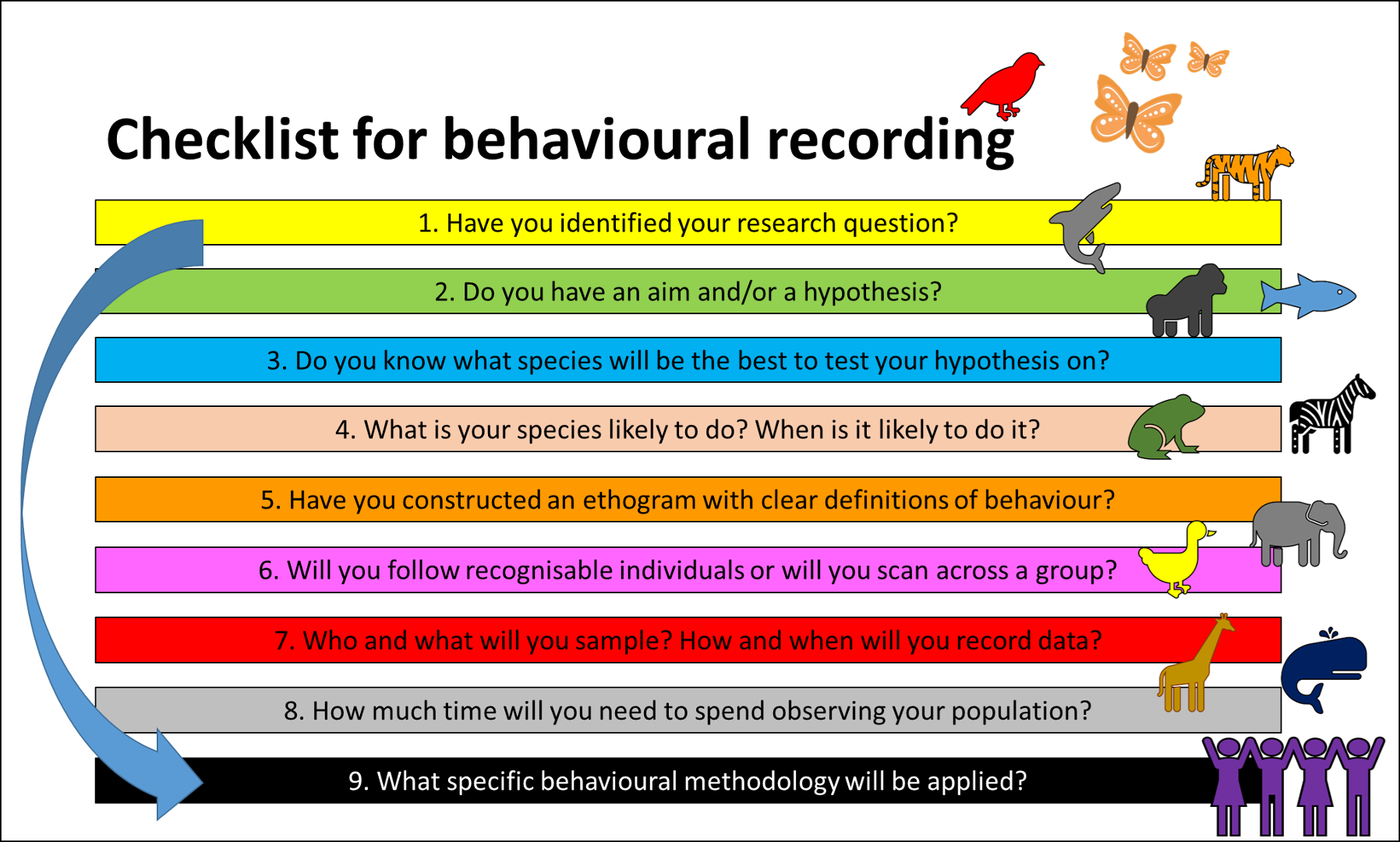(7) animal behaviour RM
1/32
There's no tags or description
Looks like no tags are added yet.
Name | Mastery | Learn | Test | Matching | Spaced |
|---|
No study sessions yet.
33 Terms
things to remember about behaviour
behaviour is all observable responses that an individual / animal gives to internal or external stimuli - can see and record
stimuli = events that cause an organism to perform an activity or start a reaction
can manipulate the stimuli and see how the behaviour changes
this allows us to infer the reasons why behaviours occur to be made and tells us about the individuals physiology, psychology and wellbeing
behaviour:
normally involves movement
categorised by particular types (they tell us the underlying physiological and psychological state of the animal)
social behaviours - interaction (directed behaviours) to another individual
may be associative, performed by individuals in the same space and time
or interactive, animals doing something to another
foraging behaviours - set pattern that a species uses to locate and identify food
tells us a bout internal motivation and energetic requirement
behaviour can be what?
pure
applied function of animal behaviour
what is the pure function
evolutionary biology - where have we come from, who are our most common ancestors and how does this impact behaviour
behavioural ecology - how has the animal evolved to the habitat it lives in
compare cognition and consciousness - where do our brain abilities come from
human and animal comparisons - sheds light onto the reasons and mechanisms for behaviour
e.g. how do evolutionary trends affect the mental health crisis
pure behaviour studies at UoE
evolutionary components to human behaviour
cross species comparisons (aggression, sociality)
social networks analysis can measure a behaviour and how its similar across species
why do behaviour occur in the form that they do (e.g. problem solving or learning)
squirrels and how their behaviour has evolved
what is the applied function
provides data that can be used for
improving how we keep and manage animals
improving how we interact with animals that we use (improving quality of life for cows improves their milk yield)
adding to our understadning of internal motivation and the reasons for behavioural performance
need to understand motivations for performance
e.g. allow giraffes feeding behaviours or they will show abnormal patterns of behaviour
what is a key aspect of the applied function
animal welfare
the state of an individual as it attempts to cope with its environment (Broom, 1986)
can measuring coping and look at individual state by observing behaviour
humans interacting with animals influences their quality of life
5 domains fro animal welfare assessment
physiological domains - what we provide the animal with
nutrition
living environment
health and fitness
behavioural domain - things we can measure
interactions with humans
interactions with other animals
interactions with the environment
example of observations
when we group participants must make sure there are specific descriptions of what we are examining so data can be repeated
observational with experimental approach
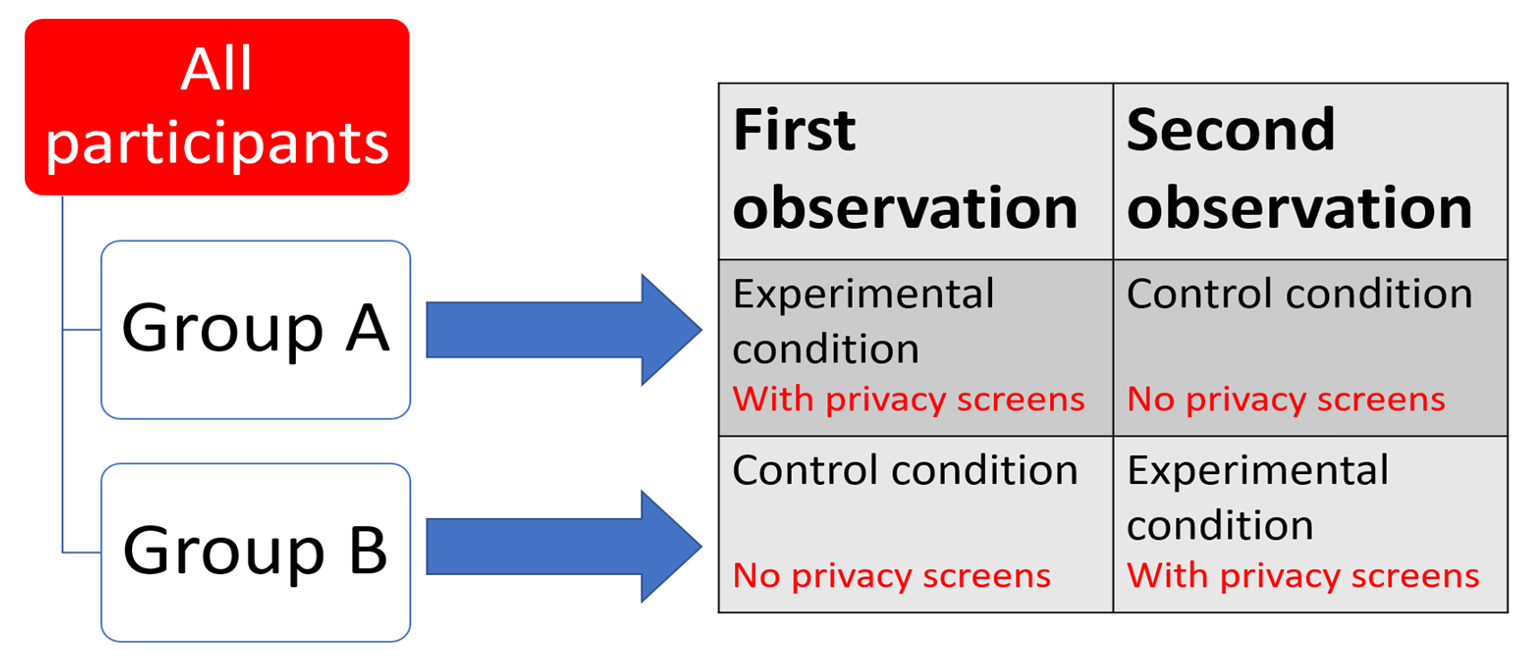
types of animal behaviour (more on this later)
states - long duration / anything you can time
events - short duration / anything that can’t be timed (vocalisation, bout of aggression)
bouts - the grouping of events into a set pattern (courtship ritual)
sequence of events that can be stitched together (e.g. mirror, signal, manoeuvre)
what do these behaviours tell us?
ethogram - list of all behaviours the individual will perform built from the literature (define and describe)
e.g. sleeping - lion is unconscious but breathing (must be very specific)
time-activity budget → energy → motivation
lots of energy means a high motivational state
inferences of motivation come from what we have recorded
animal welfare = state of the individual… infer via behavioural observation
ss is a population of monkeys that moved from one enclosure to another, the behavioural states change which are helpful for understadning choice, preferences and quality of life (grooming, dozing and being awake linked to environmental changes)
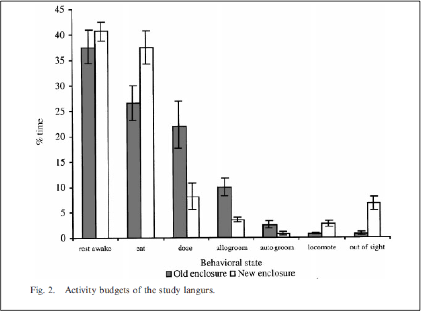
planning a behavioural study, what needs to be considered
it is complex and need to take into account many variables
independent
dependent
extraneous (weather, time, other people)
hypotheses
null
alternative / experimental
sampling and recording
sampling
who to follow and watch, and what to measure (e.g. how two individuals form a social bond and whether the presence of others influences the social dynamic)
recording
how and when to observe / record information (e.g. when the giraffes are alone and when another individual is present)
focal individual - know the animal you are following
scan sample - individuals in a group, hard to identify
ethical review - stringent process, write your methods and submit for peer review
have a duty of care to look after animals welfare
the species observed and question being asked will dictate the recording methods utilised in the experimental design
different recording techniques
recording techniques
instantaneous (e.g. instant, scan sampling of a group or individual), good if you know the individual but can’t do continuous due to setup/environment
divide the sample period into short intervals and record behaviour on the time point, need to be close enough so nothing is missed but not so close that we get pseudo-replication (do not give subject time to change behaviour naturally)
instantaneous focal sample - note the behaviour occurring at every time point (e.g. record every 2 mins for an hour) - might be walking, feeding, standing
or can do an instantaneous scan sample of all animals but give the number of individuals performing each behaviour at each time point
overall score expressed as a proportion of the observation time
continuous - recording the total time spent by an individual on each behaviour, good if you know the individual
exact record of behaviour recorded at each occurrence (mins or seconds on each), keep timing behaviour until animal does something else
necessary for true frequencies / duration
one-zero sampling (yes I saw it, no I didn’t, good for rare activity)
record whether the behaviour has occurred in sample period
have same observation time of an hour, broken down into 2 mins and say whether you see the particular rare behaviour - can then work our the rate the behaviour occurs for
often goes in conjunction with behavioural sampling
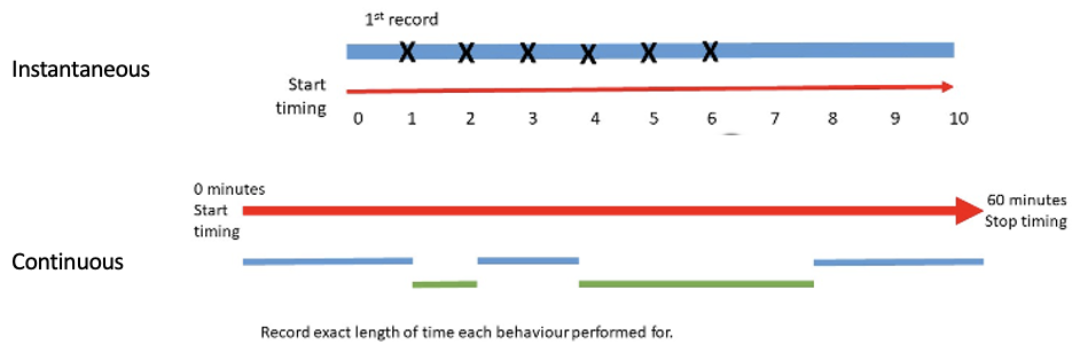
different sampling techniques
sampling techniques
ad lib sampling (e.g. write down and see what occurs, use for an ethogram) - all behaviours are recorded
good for creating an ethogram
focal sampling - focus on one individual
scan sampling - scan group at regular intervals (different behaviours in the group being performed - good if you can’t tell individuals apart)
behavioural / event sampling - record occurrence of a particular behaviour (good if that behaviour is the focus)
tally chart for a frequency or rate (all-occurrence)
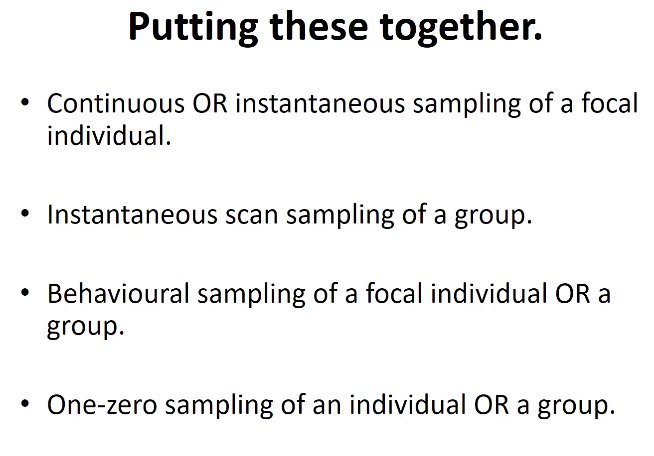
about sample sizes
want as many subjects as possible (but case studies are useful too)
as much data as possible
this will allow us to determine if the data follows a normal distribution
stats and significance will depend on what you have watched / observed / counted
t-tests are really good for behavioural data - allow us to decide on other tests to do to figure out where particular differences lie
can ignore the idea they only work on parametric data as long as you have a fairly large sample (25+), t tests will still provide valid inferential analysis
t-tests for comparing animals
one sample t-test good for comparing a treatment against a baseline
know the average amount of time giraffes should chew for, then compare how long our sample spend chewing with the published mean
paired t-tests are good for comparing data from a population measured twice
differences between feeding and foraging in the morning and afternoon and compare within same population
can also do post hoc testing to see where differences caused by variables like age category lie
repeated measures testing is really good to tell us what is effecting behaviours being observed
example of continuous recording
focal sample as we know who they are
may be interested in motivation using forced swim test or using a wheel
start stop watch when its on the wheel and stop it when the mouse gets off
can see whether depression effects how the animal engages with the environment
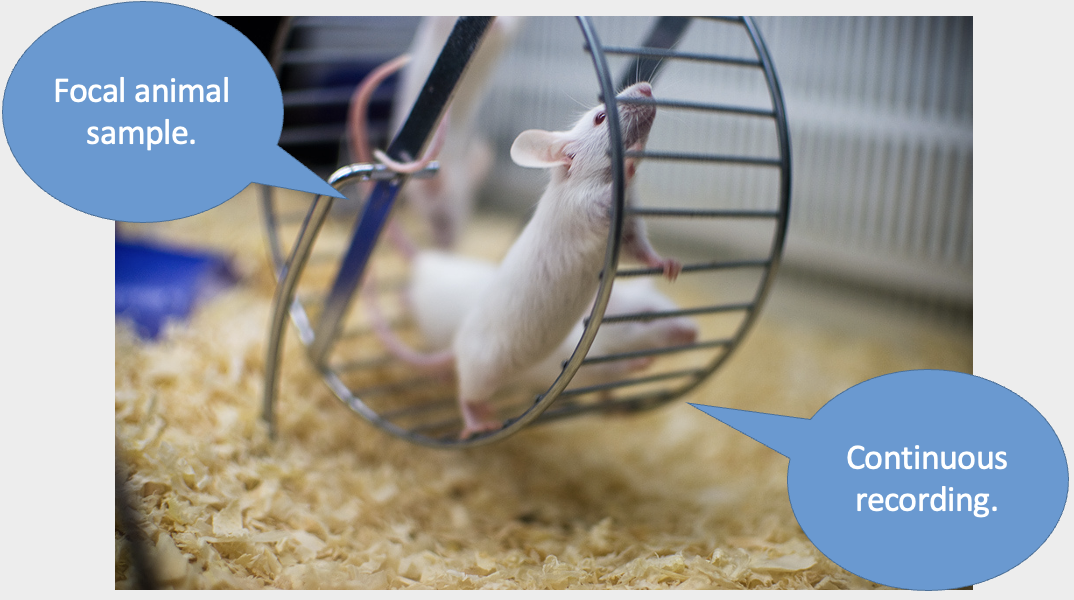
example of instantaneous recording
scan sample as cannot tell who is who
so have to do scan instantaneous recording
take 20 and count behavioural data at each time point
time intervals need to be based on the ecology of the species
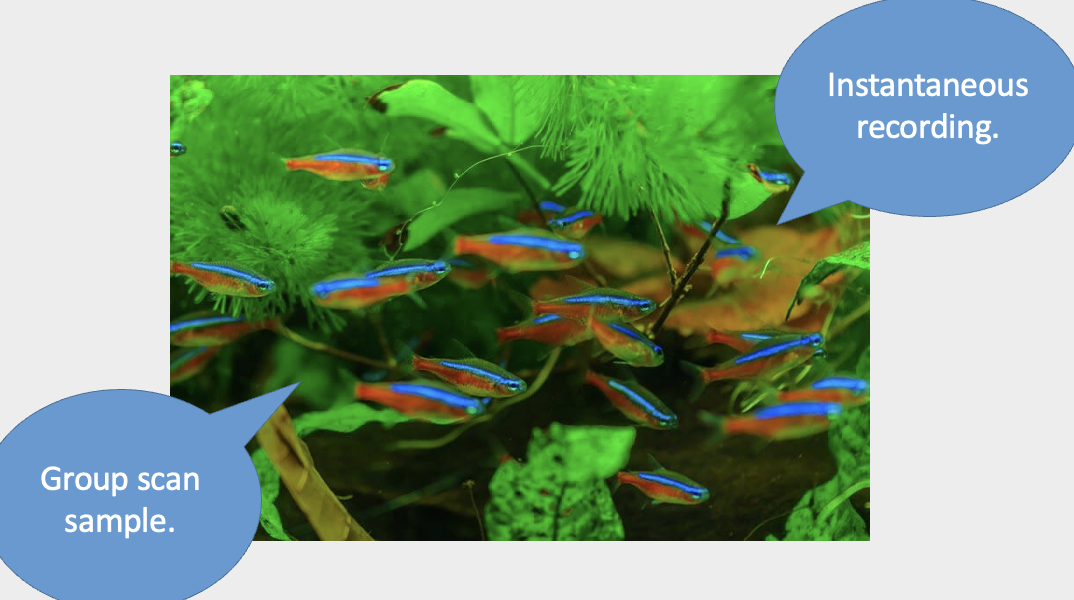
example of one-zero recording
rare behaviour of throwing their backs in the air and belching
every 2 mins watching ducks and looking at how long they spend swimming and not swimming
every 2 mins ask have i seen this display, yes or no (coded 0 or 1)
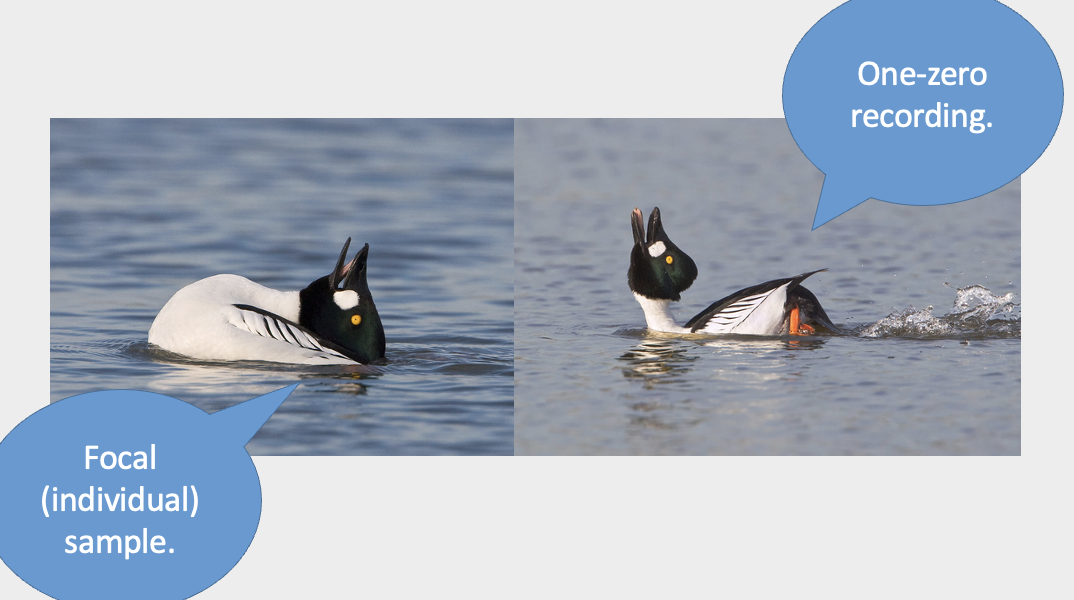
more on the different measures of behaviour
frequency
the number of occurrences of the behaviour per unit of time (e.g. how many times see the courtship display within an hour)
duration
the length of time for which a single occurrence of the behaviour lasts (how long does the courtship behaviour last)
latency
the time from a specific stimulus to the first occurrence of the behaviour - good for lab studies (e.g. provide animal with enrichment, then how long until the first important behaviour)
bouts
a short period of a specific activity, normally intense, that can be timed (good for vocalisations)
will have a specific start and end point and a latency between bouts is required for measurement
e.g. courtship - all behaviours that make up the dance is the bout and the latency is the time for the group to get organised then to start performing the courtship display
some behaviours allow us to split the activity into bouts (latency is before foot stamping, bout is the foot stamping, then once its finished how logn until it start again)
but what about quick stuff that is hard to time
many event behaviours that occur instantaneously (biting, pecking, licking, scratching are events, socialising is the state)
walking, feeding etc are state behaviours that can be in a time-activity budget
but if you can’t time it, it cannot be in a time-activity budget
these are event behaviours and must be counted and displayed as a frequency or rate (of occurrence)
divide total number of times seen event by observation time and this gives us rate
ad lib sampling helps with this as you can do states and events at the same time
what are time-activity budgets
proportion of behaviours displayed during the study period
e.g. a group of pigs watched for 5 hours
15% of the time was spent foraging
20% was spent asleep
would need to show error (using SE or SD bars for an average time-activity budget)
this would be expressed graphically to show how the individuals expend energy on behaviour (and therefore shows us the importance of each activity)
time = energy = motivation
recording sheets
record as much of the ‘noise’ as possible to explain any behaviours you may observe
scan is the count of number of animals performing that behaviour rather than a cross
can then calculate mean and SD
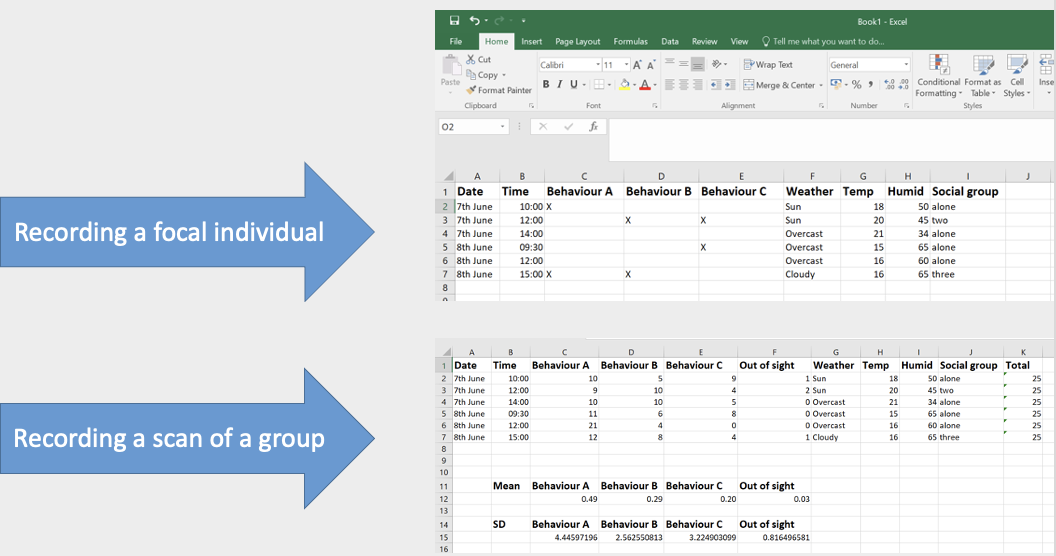
data entry sheet
this tells us what happens at what time, at what date and all the other information around it
this allows for analysis of predictor variables and easy application into Jamovi

developing work
seek out precedent and use the literature
base your methods on those that are published (remember to cite!) - this is not plagiarism!!
record states and events at the same time - maximise the amount of data you can record
think about the question you want to answer and the most appropriate species to use to answer it - is it a causation, development, an evolution, function etc question
ethics and peer review
Animal Scientific Procedures Act regulates use of all animals that are mammals, bird, fish, reptiles, amphibians and 2 invertebrates (octopi and crustaceans)
need home office licence if keeping animals
comments and feedback are required to ensure valid methods are provided
check the quality of evidence used in support of your aims and research question
always comply with legislation and policy surrounding animal welfare and ethical practices
ethics form includes the 3 R’s
Reduction - have you reduced the number of animals to the most statistically relevant population (best possible for statistical significance)
Refinement - have you considered this is the best species to use (why do you need a primate, not a mouse, why can’t it be done on humans)
Replacement - what is it that you can change or adapt that means we don’t have to use animals or can you use technology to reduce your presence and improve animal welfare, don’t wear same colours as the keepers
good welfare = better results
what makes animal behaviour good compared to human research
animal subjects won’t decide not to participate
they can be managed in one place
provide real world insight into the human world from applied and pure perspective
animal research is covered by the same ethical review as human research
example study
Rose & Robert - activity patterns and enclosure usage of a little-studied zoo species, the sitatunga (antelope)
time-activity budget on an individual level - can see where behavioural differences lie
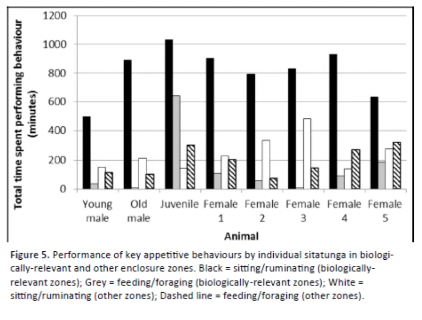
calculating daily activity patterns
these can be calculated quite easily using animal behaviour data
create a behavioural profile for the animal over a 24 hour period
best if behavioural observations have occurred during night and day
use of technology allow for this
or can do over a 12 hour daylight period if cannot do 24 hours to see how behaviour changes on a temporal scale
need to apply relevant methods to each species (e.g. no good collecting data on owls during the day)
example of fluctuation in activity overtime
% of time on each behaviour (feeding and rumination)
time on day on x axis
measuring this gives us a good understudying of welfare state to allow for us to positive impact animals quality of life in zoo’s
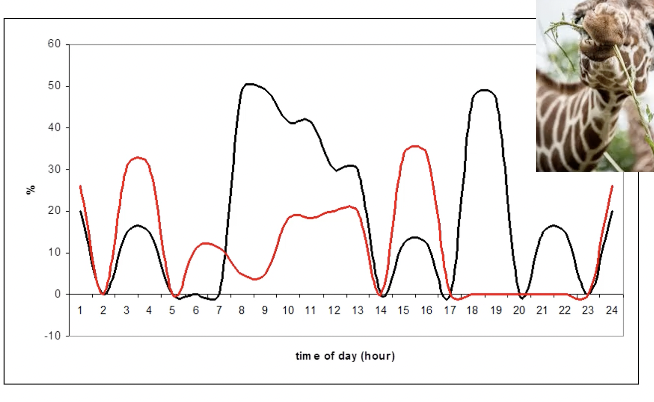
do’s for animal behaviour research
run pilot study - know animals, the population, what you are going to do and the constraints
read papers detailing similar species or similar research question before starting
con struct ethogram before you begin
base methods on precedent
don’ts
do not continue using a sampling protocol that is not generating useful or valid data
do not assume that you need hours and hours of data to collect accurate information on specific aspects of animal behaviour
however, don’t think behaviour is an easy research option - quality data is better than quantity
evaluating data
think question and not species
introduce the bigger picture, what element of behaviour are you studying
then introduce species because that is what you are testing question on
analyse data using appropriate inferential stats
expand discussion and conclusions to show application to the wider world (why does the research matter)
checklist for behavioural recording and summary
sampling
who to watch
what to measure
focal
scan
behavioural
event
recording
how to watch
when to measure
continuous
instantaneous
one-zero
